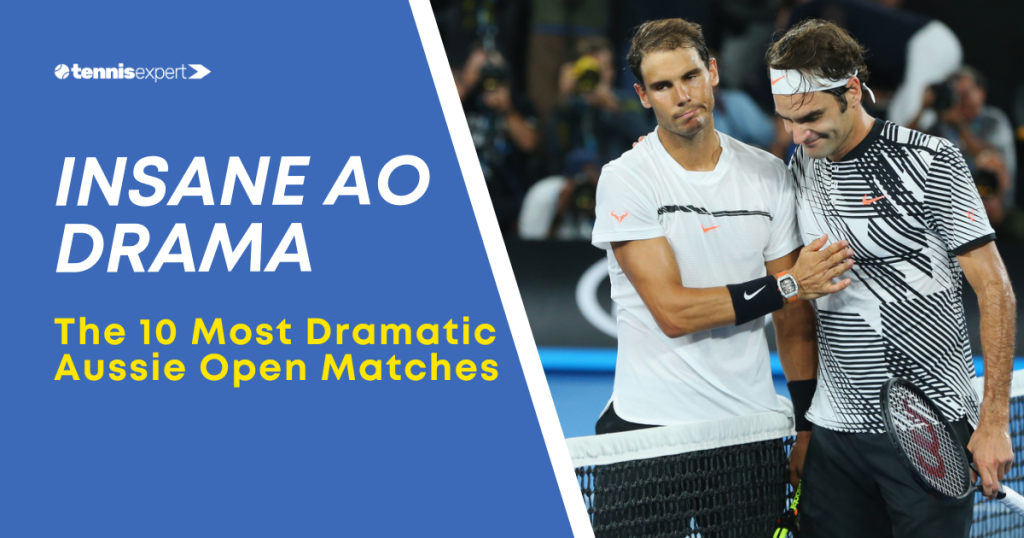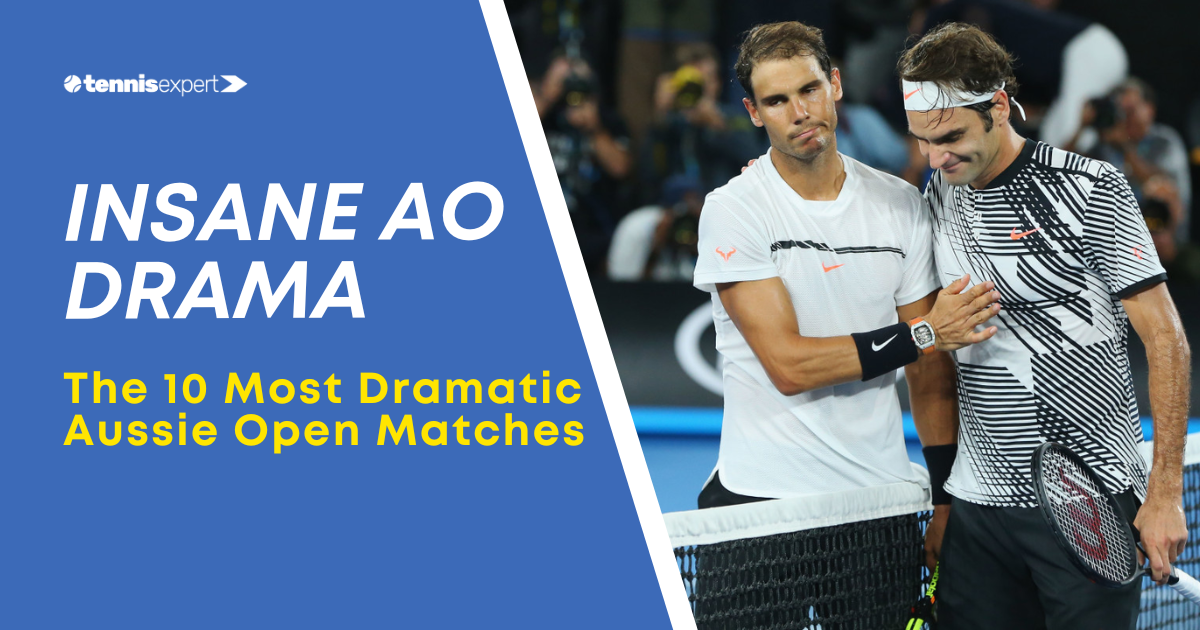The Australian Open has a knack for serving up high-octane drama that keeps spectators on the edge of their seats. Whether it’s the soaring temperatures that test the players’ endurance or the electrifying atmosphere under the lights of Melbourne Park, this Grand Slam tournament has a storied history of creating nail-biting encounters.
Memorable matches are a staple of the Australian Open, where comebacks are mounted on the hardcourt and legends carve deeper notches in their legacy. In the 2022 edition, fans were treated to a string of such encounters, each packing a punch equivalent to a finely placed ace. From the sheer willpower of tour veterans to the audacious flair of rising stars, the tournament showcased the full spectrum of what makes tennis a gripping spectator sport.
These are the contests that become instant classics, talked about in reverent tones long after the trophies have been hoisted and the champions’ names etched into silverware. Each January, Melbourne Park doesn’t just host a tennis event; it sets the stage for a breathtaking display of human spirit, skill, and, incredible drama.
Here are the 10 most dramatic matches ever seen at the Australian open.
Dramatic Australian Open Matches: Epic Battles and Unforgettable Moments
Gerald Patterson vs. John Hawkes, 1927
The 1927 Australian Championships held one of the most sensational matches in its history during the Men’s Singles final. Gerald Patterson and John Hawkes, who were also doubles partners, faced off in a gripping contest that is still remembered today for its sheer endurance and drama.
- Patterson’s triumphant victory came after a grueling five-set match.
- The final scores read 3-6, 6-4, 3-6, 18-16, 6-3 in favor of Patterson.
What was remarkable about the final set was the length and intensity. The fourth set’s 18-16 outcome attests to the resilience and determination of both players. Their formidable partnership in doubles clearly translated into an equally formidable opposition when they were on opposite sides of the net.
- Hawkes had his chances, five championship points, to be exact, but Patterson’s tenacity ultimately prevailed.
This match is a testament to the enduring spirit of the sport, where physicality meets mental fortitude. The 1927 clash between Patterson and Hawkes will long be hailed as one of the most dramatic matches in the history of the Australian Open.
Adrian Quist vs. Jack Crawford, 1936
The 1936 Australian Championships provided a stage for an epic battle between Adrian Quist and Jack Crawford, culminating in a dramatic men’s singles final. Quist, who was fighting to establish his dominance in Australian tennis, faced off against Crawford, the defender of the title.
Quist won the match in a grueling five-set encounter, the scores reading 6-2, 6-3, 4-6, 3-6, 9-7. After seizing the first two sets, Quist’s victory seemed imminent, but Crawford, not ready to relinquish his crown without a struggle, battled back, winning the next two sets to even the match.
- First Set: Quist 6-2
- Second Set: Quist 6-3
- Third Set: Crawford 6-4
- Fourth Set: Crawford 6-3
- Fifth Set: Quist 9-7
The final set was a nail-biting affair that truly tested the mettle of both players. They pushed each other to the limits until Quist finally broke Crawford’s resistance, taking the fifth set 9-7.
The victory was significant for Quist who not only claimed the championship but also earned the distinction of being Australia’s top-ranked tennis player. Fans at the Memorial Drive courts in Adelaide witnessed a superb display of skill and tenacity from both athletes. Their performance on that day is remembered as one of the most thrilling chapters in the history of the Australian Open.
Rod Laver vs. Neale Fraser, 1960
In the 1960 Australian Championships final, Rod Laver faced off against Neale Fraser in a contest that has since been etched in tennis history. Laver, seeded third, sought his first singles major title, while Fraser was an established competitor.
The final turned out to be a marathon match. Laver found himself on the brink after losing the first two sets, with scores of 5-7 and 3-6. As the match progressed, however, Laver began to claw his way back, showcasing the resilience that would later define his legendary career.
Laver took the third set 6-3, initiating a momentum shift that set the stage for an epic comeback. The fourth and fifth sets were tightly contested, with Laver pulling off a narrow victory in both, with identical scores of 8-6.
- Final Score:
- Set 1: Fraser 7, Laver 5
- Set 2: Fraser 6, Laver 3
- Set 3: Laver 6, Fraser 3
- Set 4: Laver 8, Fraser 6
- Set 5: Laver 8, Fraser 6
His triumph at the Australian Championships stood as a testament to Laver’s tenacity, as he had to overcome not just a two-set deficit, but also a match point against him. This victory was a turning point for Laver, marking the beginning of a golden era in his career, ultimately shaping his status as one of the greats of the game.
Rod Laver vs. Tony Roche, 1969
The semi-final of the 1969 Australian Open is etched in tennis lore, featuring a titanic struggle between two Australian legends, Rod Laver and Tony Roche. Their encounter was not just a display of skill and endurance but also a test of wills under the intense Australian sun.
Laver, affectionately known as “The Rocket,” was at the peak of his prowess, chasing an unprecedented calendar-year Grand Slam. Roche, no less formidable, was determined to upset Laver’s quest. The match became a marathon, stretching the players to their physical limits.
During the semi-final:
- Set Scores: Laver edged past Roche with a nail-biting 7-5, 22-20, 9-11, 1-6, 6-3 scoreline.
- The second set alone was an extraordinary showcase of stamina, ending 22-20 in Laver’s favor.
Their performance was marked by:
- Intense rallies, befitting of two of the era’s best serve-volley players.
- Resilience, particularly from Laver, who overcame the adversity of Roche’s challenge in grueling heat and humidity.
The victory for Laver in this semi-final was pivotal. It set the stage for:
- His Grand Slam quest.
- A relatively more straightforward final against Andres Gimeno, which he won 6-3, 6-4, 7-5.
While this match was a stepping stone for Laver’s historic Grand Slam, it also highlighted the caliber of tennis that defined the era—compelling, dogged, and unyielding. The 1969 Australian Open semi-final between Laver and Roche remains emblematic of the drama that the Australian Open is known to deliver.
Martina Navratilova vs. Chris Evert, 1981
In one of the most memorable meetings at the Australian Open, Martina Navratilova faced Chris Evert in the 1981 final. This match is often recalled for its high stakes and intense rivalry between two of tennis’s greatest female players.
- First Set: Evert came out strong, managing to clinch the set in a tiebreaker (7-6 [7-4]).
- Second Set: Navratilova fought back, securing the set (6-4) to level the match.
Evert’s tactical precision met Navratilova’s aggressive playstyle, creating a dynamic and suspenseful match. It was Navratilova’s power and adaptability that finally tipped the scales.
- Final Set: After a see-saw battle, Navratilova took the deciding set (7-5).
This victory marked Navratilova’s first Australian Open singles title and added a third major singles title to her growing collection. Their showdown is remembered not only for the quality of tennis but also for the resilience and determination shown by both athletes.
During the tournament, Evert had dispatched the defending champion, Hana Mandlíková, in the quarterfinals, which set the stage for the classic final. The rivalry between Evert and Navratilova is legendary, and their clash at the 1981 Australian Open stands as one of their many epic encounters.
Mats Wilander vs. Pat Cash, 1988
In what’s considered one of the most riveting showdowns in tennis, Mats Wilander faced Pat Cash at the Australian Open 1988 final. Wilander, with exceptional baseline play, and Cash, known for his aggressive serve-and-volley style, clashed on the newly introduced hard courts of Melbourne Park.
The match stretched to five grueling sets. They battled fiercely with Wilander ultimately claiming victory. The scoreline was a testament to the tight contest:
| Set | 1 | 2 | 3 | 4 | 5 |
|---|---|---|---|---|---|
| Wilander | 6 | 6^(3) | 3 | 6 | 8 |
| Cash | 3 | 7 | 6 | 1 | 6 |
Wilander’s win wasn’t just another title; it was his third Australian Open and fifth major singles triumph. His victory ended in a remarkable 4 hours and 28 minutes, making it a classic for tennis aficionados.
Despite a passionate home crowd cheering him on, Cash couldn’t capitalize on his previous year’s momentum and finished as runner-up once again. This intense battle marked not only a highlight of the tournament’s history but also a pivotal moment in both players’ careers.
Serena Williams vs. Venus Williams, 2003
The 2003 Australian Open witnessed a compelling final between the Williams sisters, Serena and Venus. It was more than just a match; it was a battle of siblings for a major title.
Head-to-Head Before the Match: Serena Williams and Venus Williams, two titans of the sport, met for a memorable showdown at Melbourne Park. Their rivalry was well-known, with both having multiple Grand Slam titles to their names.
Match Significance: Serena Williams was eyeing a “Serena Slam”—holding all four major titles consecutively. A win here would secure her place in tennis history.
- Set Scores:
- Serena: 7-6(4), 3-6, 6-4
- Venus: 6-7(4), 6-3, 4-6
Match Dynamics: The final unfolded with high intensity. The first set saw Serena edge out Venus in a tense tiebreaker. In the following set, Venus responded with determination, breaking Serena’s serve to win 6-3. The third set was decisive, with Serena clinching the victory in a gripping back-and-forth climax.
Historical Context: Serena’s victory marked her fourth consecutive Grand Slam title, a feat that placed her among the sport’s legends. She displayed raw emotion as she lifted the trophy, a testament to the significance of her achievement.
Complex Emotions: Amidst the intensity, there was a palpable sense of respect and sisterly love, adding a unique dimension to an already dramatic contest. Each point was contested with a blend of familial camaraderie and competitive spirit.
The match remains a highlight in the history of the Australian Open, embodying the drama that can only come from a family rivalry played out on one of the world’s biggest stages.
Rafael Nadal vs. Roger Federer, 2009
The 2009 Australian Open final is etched in the annals of tennis history for the epic encounter between Rafael Nadal and Roger Federer. Their rivalry had already become the stuff of legend, but this match elevated it further.
Nadal entered the court with the indomitable spirit he’s known for. Federer, with his immaculate record on the line, was aiming to secure his 14th Grand Slam title to equal Pete Sampras’ record. The match was a thrilling display of athleticism, skill, and mental fortitude.
Match Score
| Set | 1 | 2 | 3 | 4 | 5 |
|---|---|---|---|---|---|
| Nadal | 7 | 3 | 7 (7-3 Tiebreak) | 3 | 6 |
| Federer | 5 | 6 | 6 | 6 | 2 |
The final swung like a pendulum, with each player showcasing their brilliance. Federer started the first set with unforced errors, giving Nadal an early break, but despite this, Federer’s forehand winners were noteworthy, hinting at the Swiss maestro’s resolve.
Nadal, on the other hand, demonstrated exceptional tenacity, particularly in the third-set tiebreak, which he won. Although Federer fought back to take the fourth set, Nadal’s relentless pressure and endurance were decisive in the fifth.
The match concluded with Nadal taking victory after around 4 hours and 23 minutes of play, marking his first-ever hard-court Grand Slam title. The emotional toll of the match was palpable, with Federer’s tears during the trophy ceremony a reflection of the match’s intensity and his respect for his great rival. Nadal’s 7-5, 3-6, 7-6 (7-3), 3-6, 6-2 win was not just a triumph of a player, but a celebration of tennis at its finest.
Novak Djokovic vs. Rafael Nadal, 2012
In a thrilling encounter at the 2012 Australian Open, Novak Djokovic and Rafael Nadal battled in what became one of the most dramatic matches in tennis history. This final was marked by its duration, intensity and the exquisite level of play from both competitors.
Stretched over 5 hours and 53 minutes, their clash set the record for the longest Grand Slam final in history. Djokovic eventually emerged victorious with a scoreline of 5-7, 6-4, 6-2, 6-7 (5-7), 7-5. Each set was a testament to their astonishing stamina and mental resilience.
| Set | 1 | 2 | 3 | 4 | 5 |
|---|---|---|---|---|---|
| Djokovic | 5 | 6 | 6 | 6 (5-7) | 7 |
| Nadal | 7 | 4 | 2 | 7 | 5 |
The match saw countless momentum shifts, with Djokovic losing the first set before making a comeback in the next two. The fourth set was particularly nail-biting, with Nadal edging out in a tiebreak. However, Djokovic rallied in the deciding set, securing his victory.
Nadal displayed his characteristic grit, but Djokovic’s precision and composure ultimately gave him the edge. Fans witnessed a wide array of shot-making and strategic plays. Long rallies and breath-taking winners were routine throughout the contest.
Their performances cemented the 2012 Australian Open men’s final as a benchmark for endurance and quality in tennis. It was a defining moment in their storied rivalry, celebrated for its grandeur and the sheer willpower demonstrated by both players.
Roger Federer vs. Rafael Nadal, 2017
In 2017, the Australian Open witnessed one of its most memorable matches when Roger Federer met Rafael Nadal in the final. The match took fans on an emotional roller coaster as both players, known for their legendary rivalry, clashed in a five-set thriller.
- Set Scores: Federer won the match with the following set scores:
- 1st Set: 6-4 (Federer)
- 2nd Set: 3-6 (Nadal)
- 3rd Set: 6-1 (Federer)
- 4th Set: 3-6 (Nadal)
- 5th Set: 6-3 (Federer)
This victory was particularly special for Federer as it marked his 18th Grand Slam title, extending his record at the time. In contrast, Nadal, with a powerful head-to-head record against Federer, was seeking his 15th Grand Slam title.
- Notable Statistics:
- Grand Slam Count: Federer (18), Nadal (14 tied with Pete Sampras)
- Head-to-Head Record: Nadal led 23-11 prior to this match
The intensity of the match complemented their storied history, with spectators witnessing an array of brilliant shots and tireless athleticism. After a demanding four sets, Federer’s ultimate breakthrough came in the decisive fifth set, demonstrating his relentless pursuit of excellence and a never-say-die attitude.
Tennis enthusiasts around the world celebrated the quality of the match. It not only highlighted the skills of Federer and Nadal but also the respectful rivalry that exists between them, further cementing this face-off as one of the sport’s classics.

Introducing The Tennis Expert, your insightful guide into the world of tennis. With a passion for the game that started in childhood, they have dedicated years to studying and understanding every nuance of tennis. Their keen eye for detail and deep knowledge of the sport's strategies, history, and evolving trends make them a reliable source for tennis enthusiasts. Whether breaking down a classic match or offering tips for players, The Tennis Expert combines a fan's love for the game with an analyst's eye.





